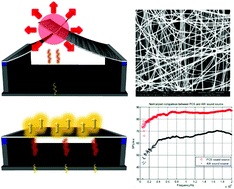A point acoustic device based on aluminum nanowires†
Abstract
A point Electrical Thermal Acoustic (ETA) device based on aluminum nanowire contacts is designed and fabricated. Interdigitated structural aluminum nanowires are released from the substrate by Inductively Coupled Plasma Reactive Ion Etching (ICP-RIE). By releasing the interdigitated structure, the nanowires contact each other at approximately 1 mm above the wafer, forming a Point Contact Structure (PCS). It is found that the PCS acoustic device realizes high efficiency when a biased AC signal is applied. The PCS acoustic device reaches a sound pressure level as high as 67 dB at a distance of 1 cm with 74 mW AC input. The power spectrum is flat, ranging from 2 kHz to 20 kHz with a less than ±3 dB fluctuation. The highest normalized Sound Pressure Level (SPL) of the point contact structure acoustic device is 18 dB higher than the suspended aluminum wire acoustic device. Comparisons between the PCS acoustic device and the Suspended Aluminum Nanowire (SAN) acoustic device illustrate that the PCS acoustic device has a flatter power spectrum within the 20 kHz range, and enhances the SPL at a lower frequency. Enhancing the response at lower frequencies is extremely useful, which may enable earphone and loudspeaker applications within the frequency range of the human ear with the help of pulse density modulation.


 Please wait while we load your content...
Please wait while we load your content...